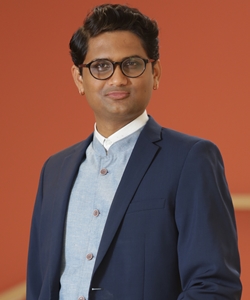 With a new gallery up and running in eastern Auckland, Business to Business posed a few questions about the finer points of his role in the world of art and business to curator of Uxbridge’s Malcolm Smith Gallery, Balamohan Shingade.
With a new gallery up and running in eastern Auckland, Business to Business posed a few questions about the finer points of his role in the world of art and business to curator of Uxbridge’s Malcolm Smith Gallery, Balamohan Shingade.
– Can art be a profitable investment or is it more about the love of possessing beautiful things?
New Zealand’s creative industry adds $3.85 billion to our gross domestic product (GDP) every year, and is a huge contributor to our national employment. But at the individual level, it would be a terrible mistake to purchase a painting or an object simply as an investment. In doing so, we would fail to recognise the real relevance of art.
Yes, art is entertaining and often beautiful, but a good artwork is also challenging. Artists help us make sense of our world. They broaden our experience, understanding, and enable us to imagine the unimaginable. They connect us to the most important questions of contemporary life, like ‘how do we live together?’
– What does it mean to be a curator, especially for a contemporary art gallery?
Over the past decade or so, the word curating has increasingly been used to describe anything that involves choosing and ordering things—making a party playlist, for example, or artfully arranging furniture. But the word is widely misused and abused. Curate comes from the word ‘cure’, like treating something.
Curating is not simply about choosing artists, coming up with a title and calling it an exhibition; it requires being interested in the meaning art produces, its significance and relevance, and as a curator, I am responsible for organising this within the context of the gallery for which I work.
– You were working at Elam School of Fine Arts as a Professional Teaching Fellow. When did you take on the role of manager and curator at Malcolm Smith Gallery?
I started in January 2015, when the redevelopment of Uxbridge and the launch of the new Malcolm Smith Gallery were imminent. The redevelopment has been an opportunity for us to re-think and refresh our visions, something I believe all institutions must regularly think through.
– What will the Malcolm Smith Gallery play in Auckland and how will an outer suburb such as Howick benefit?
Lay people often fear contemporary art galleries so, our ambition is to create an approachable, warm space, but without compromising an artist or his/her work. We’re interested in showing work that is globally minded yet locally rooted. In fact, in the Howick Ward, close to 40% of the total population identify with an Asian ethnic identity.
As a location with one of the highest numbers of Asian New Zealanders, Malcolm Smith Gallery aims to connect to a wide network of art institutions, practitioners and audiences around the Asia-Pacific rim to show a leading example in shaping the success of Asian arts and cultural practices in New Zealand. We aim to offer a space for East Auckland with a sense connectedness, a gallery in the idyllic surrounds of Howick that is part of a global conversation on contemporary art.
– What can visitors to the gallery expect from upcoming exhibitions?
There is something thrilling to look forward to in each exhibition and I have challenged myself and the gallery to go a little bit further with each show, whether it is through experimental exhibition design, the publication of catalogues, or supporting artists through brave new projects.
– Is there a particular medium you prefer? What types of pieces do you have on display in your own home?
I often find myself more interested in what a particular artwork has to say, rather than what it looks like. I like all media equally, because for me, form follows content. I own several artworks at home, mostly paintings and small objects, but none of them are purchased. Each artwork tells a different story—an exchange between friends, a housewarming present, an engagement gift.
– While you hold a masters degree in fine arts, many forgo higher education in this field. How beneficial have your qualifications been?
At art school, our creative capacities were extended. We were afforded the freedom to experiment, take risks and realise brave new projects that contributed to wider socio-political debates.
Elam School of Fine Arts has produced a plethora of internationally significant artists, but many of our country’s best graphic designers (Alt Group), film directors (Florian Habicht), even bands (Split Enz) are also art school alumni. As for myself, I am a curator by profession.
– You’re also an accomplished writer. Who are your favourite authors?
Of the countless writers I could possibly mention, my favourites are those I’ve learnt from the most. I admire my mentors and my peers because their writings help me make sense of the world in which we live, most especially, Anthony Byrt, Jon Bywater, Erena Johnson, Tessa Laird, and Allan Smith.
– If you could be Minister for Culture and Heritage for one day what would you do first and why?
The arts industry is facing a $2.3 million drop in funding from the NZ Lottery Grants board this year. For what it’s worth, I’d like to suggest that the arts are not a lottery. I would call for more secure investment in the arts, and would hope to untangle the strange relationship it shares with the lotteries.
– If you could invite any three artists (living or dead) to dinner, who and why?
I’d love to be defeated by Marcel Duchamp in a game of chess, and learn from the founder of conceptualism about leaving retinal art behind—putting art back in the service of the mind, rather than ‘retinal art’ which intends mostly to please the eye.
Mindful of making it a good dinner party, I’d also invite the Auckland-based, D.A.N.C.E. Art Club, a collective of artists (cheating, I know) who facilitate gatherings to open up conversations on contemporary art, making art accessible and very entertaining.
Finally, although she isn’t an artist per se, it would be a dream to speak with Gayatri Chakravorty Spivak, an Indian scholar whose writings give me hope.



